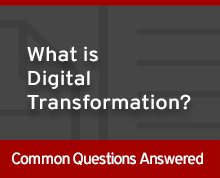A recent survey of business leaders found that nearly half (46 percent) of respondents are looking to their CIO to gain a better understanding of the digital trends and technologies that will drive their organization forward. But unfortunately, IT leaders may be part of the problem, not the solution, at many organizations. The global survey of nearly 450 business leaders was conducted by Harvard Business Review Analytic Services. The findings are outlined in a recent HBR report, “Driving Digital Transformation: New Skills for Leaders, New Role for the CIO.”
 According to the report, “Many IT organizations are not well-equipped to fill a teaching/coaching role. They need to improve the way they communicate, as well as carve out the time and create the forums for digital learning.”
According to the report, “Many IT organizations are not well-equipped to fill a teaching/coaching role. They need to improve the way they communicate, as well as carve out the time and create the forums for digital learning.”
The report lists these and other common obstacles that are standing in the way of digital education.
1. Lack of forums – Having a vision and strategy for digital growth is only half of the battle, according to the report. Organizations at the forefront of digital also have the people and processes in place that are necessary to execute upon that vision. Creating appropriate learning forums for employees across the organization should be a key part of a CIO's focus, yet 45 percent on respondents said this was their number-one barrier.
2. IT leaders are too busy – A third of respondents stated that their IT leaders do not make time for digital education. While it may be just one task on a seemingly endless (and growing) to-do list for CIOs, time spent educating peers can pay off tremendously in revenue growth and business leadership. According to the report, digital leaders are more likely to bring in outside experts to assist in digital learning while reducing time constraints on CIOs.
3. Poor communication – When business peers experience communication breakdowns, they miss the opportunity to collaborate on the right digital opportunities that will drive the organization forward. CIOs should partner closely with key business leaders to bring together the best from both domains. They can also help others identify which digital knowledge and skills need to reside in the lines of business and which should reside in IT.
4. Skill and knowledge gaps – Digital learning is not only important for line of business leaders, but those within IT must continually stay abreast of new trends and opportunities that could give them a competitive advantage. Nearly one-quarter survey respondents (23 percent) indicated that their IT leaders lacked the digital knowledge they needed to do their jobs effectively. The report suggests, “If CIOs aren’t sure where to start their digital education efforts, a good place might be with analytics training. Close to three-quarters (73 percent) rated analytics as extremely important to their area of the business ... But only a fifth (20 percent) rated their own knowledge and skills in this area highly.”
5. Technical overload – Twenty percent of respondents stated that their IT leaders get too technical or specific when attempting to share digital knowledge. With more IT budget ownership shifting outside of IT, CIOs have an increasing responsibility to ensure that all business leaders are speaking the same language and focusing on shared goals. The report suggests that CIOs create a common lexicon to increase understanding, communicating in language that makes sense from the perspective of business activities and outcomes, not IT.
Download the HBR report “Driving Digital Transformation: New Skills for Leaders, New Role for the CIO” to learn how digital leaders are prioritizing and cultivating digital acumen throughout the business.





